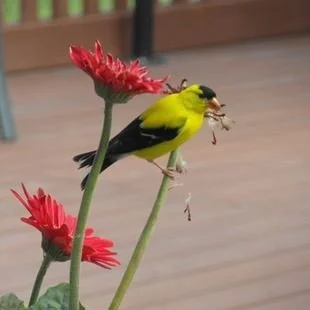SHARE
Strictly for the Birds
By Bob Turner
American Goldfinch Photo credit: Charlene Boychuck
Whether they’re winging their way north - a welcome sign of spring - nesting, singing, pecking at a feeder, or gathering to head south – brr…. here comes winter – birds have always fascinated me. I know I’m not alone.
Growing up on a farm near Riding Mountain National Park, birds surrounded me, and I became an avid birdwatcher, charting their spring arrival, studying their mating habits, building feeders and houses, and noting the departure of many in autumn. An old beat-up copy of The Birds of North America by The Audubon Society from the early 1950’s was one of my favourite books. Each year I faithfully sent 25 cents and two Kellogg’s cereal box tops to receive a fancy chart for recording the arrival of each species of bird to our area in spring. This continued into my teenage years when I switched to girl-watching (minus the fancy chart).
We often hear the terms “birding” and “birdwatching” used interchangeably, but some would say there is a difference. “Birdwatching” tends to be used to describe the casual, incidental observation of birds, with no concern for studying them in depth or details or seeking them out. “Birding” on the other hand, is seeking out and observing birds in their natural habitat as a hobby or pastime. Birders are concerned with recording their observations, often photographing birds, and often deliberately seeking out rare or unusual birds.
Whether you’re a birder or a birdwatcher, Red River North has many ideal places to see dozens of birds, and many birds that are well worth observing, either casually or deliberately.
From The Beaches in the north, the Netley-Libeau Marsh, the Brokenhead Wetland Ecological Reserve, Oak Hammock marsh area to the southwest, aptly named Birds Hill to the southeast, or all along the Red River, there are dozens of ideal places to see birds.
Some birds in Red River North are common to many areas, while some tend to be somewhat exclusive to our area.
For me, the first bird that comes to mind that tends to be unique to Red River North is found in large numbers up and down the Red River, and in abundance at the Lockport Dam and Bridge. Often referred to as The Lockport Air Force or Lockport Squadron, I covered the American White Pelican in a previous blog because it holds a fascination for me. The sheer beauty exhibited by the graceful flight of such a curious, awkward-looking bird makes it first in my books. The fishing habits of the pelicans, and their ability to engage in teamwork is also quite remarkable.
I almost feel guilty relegating The Canada Goose to second place in my personal choice list, given the significance of the bird in the area. I do hope that the folks at Oak Hammock Marsh forgive me. As far back as I can remember, along with crows and robins, the return of the magnificent V-formation of these graceful birds during their migration has been a harbinger of spring and winter. In addition their interesting habits, like devotion to their mates, their ability to marshal members of a flock into that familiar V, and training of the young in late summer and early autumn in preparation for the long trek south, are remarkable.
Of course, we can’t forget the sheer joy they provide golfers and picnickers who must navigate through the abundant dropping of these big birds in areas they frequent.
With a few exceptions, Canada Geese spend three seasons here, travelling up to 3000 miles between here and their wintering grounds along the eastern and southeastern seaboard of the U.S., making the trip in a couple of weeks.
The third member of my Top Three must be the hardy little Black-Capped Chickadee, whose cheery “Dee Dee Dee” warms your heart on the coldest of winter days. According to North American indigenous people, the chickadee symbolizes honesty and guidance, and I know from personal experience, the sound and sight of this brave little bird has cheered me up many times.
I’m sure its cheerful song could melt the coldest heart.
Some 85 to 90 per cent of the birds who can be seen in Red River North are migratory. The 10 to 15 per cent who remain include grouse, hawks, owls, woodpeckers, crows, ravens, Canada jays, chickadees, nuthatches, waxwings, sparrows, and finches. There are also a few stray species that manage to spend the winter here (eg. ducks and geese), but they are not considered regular winter residents.
The birds which stay the winter have many strategies for dealing with our cold, snowy winters. Some grow extra feathers on their bodies and legs, some fluff up their feathers to trap air close to their skin to keep warm, some huddle together for warmth, some store food, and some change their diets from insects to seeds and berries.
Again, whether birder or birdwatcher, who can fail to be impressed with the migration habits of so many different species, particularly the hardy little ruby-throated hummingbird, which may travel from 1500 to 3500 miles in late spring and early fall between its nesting and wintering grounds. This tough little creature travels all the way to Southern Mexico or Central America, with many traversing the Gulf of Mexico in an 18-to-22-hour non-stop trip, with its little wings beating over 50 times a second.
Yes, there are many reasons to be interested in birds in Manitoba, and specifically in Red River North. As I always like to remind everyone:
Whatever the season, there’s always a reason to spend time in Red River North!


